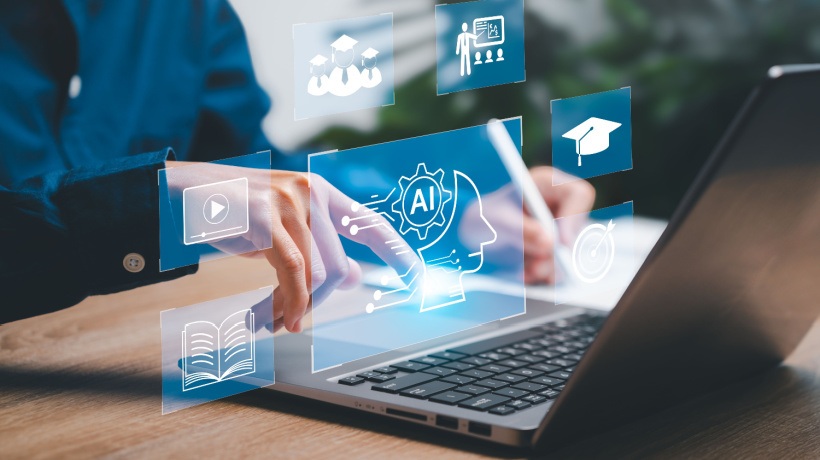Securing Connectivity With AI In Hybrid Learning
In today's rapidly evolving educational landscape, the integration of technology has become paramount. Hybrid learning, a combination of traditional in-person instruction and online learning, has emerged as a powerful educational model. With the advent of Artificial Intelligence (AI) [1], hybrid learning is experiencing a remarkable transformation. This article delves into the nexus of hybrid learning, AI, and their collective impact on enhancing security and connectivity in educational settings.
The Evolution Of Hybrid Learning
Hybrid learning represents a paradigm shift in education, offering flexibility and accessibility to learners worldwide. Initially conceived as a supplementary tool, hybrid learning has evolved into a comprehensive approach that seamlessly blends physical and virtual learning environments. Through a variety of platforms and tools, students can engage in interactive lessons, collaborate with peers, and access resources at their convenience.
The Role Of AI In Hybrid Learning
AI is revolutionizing the educational landscape by personalizing learning experiences, automating administrative tasks, and providing real-time feedback to students. In hybrid learning environments, AI-powered systems analyze vast amounts of data to tailor instruction based on individual learning styles and preferences. Furthermore, AI algorithms enhance content delivery through adaptive learning technologies, ensuring that students receive customized support and resources.
1. Enhancing Security In Hybrid Learning Environments
Security concerns have become increasingly prevalent in hybrid learning environments, necessitating robust measures to safeguard sensitive data and ensure the integrity of online platforms. Encryption protocols, multi-factor authentication, and secure data storage are essential components of an effective security framework. Additionally, regular audits and assessments can identify vulnerabilities and mitigate potential risks to student privacy and confidentiality.
2. Improving Connectivity For Seamless Learning
Connectivity is the cornerstone of effective hybrid learning, enabling students to access educational resources from anywhere in the world. High-speed internet connections, reliable infrastructure, and responsive technical support are vital for ensuring uninterrupted learning experiences. Moreover, the integration of mobile technologies and cloud-based platforms enhances accessibility and fosters collaboration among students and educators.
3. Addressing Equity And Inclusion Challenges
Despite the promise of hybrid learning, disparities in access to technology and digital literacy persist, exacerbating existing inequalities in education. Addressing these challenges requires a concerted effort to promote equity, inclusion, and accessibility in hybrid learning environments. By providing equitable access to resources, fostering digital literacy skills, and supporting diverse learning needs, educators can create more inclusive and supportive learning environments for all students.
4. Leveraging Technology For Enhanced Connectivity And Security
In an increasingly interconnected world, leveraging technology is essential for enhancing connectivity and security in hybrid learning environments. By implementing robust networking infrastructure, employing encryption and authentication mechanisms, and integrating cybersecurity best practices, educational institutions can create a safe and secure learning environment for students and educators alike. Additionally, leveraging AI-driven analytics can help identify and mitigate security threats, ensuring the integrity and confidentiality of educational data.
5. Harnessing Emerging Technologies For Enhanced Engagement
Innovations in Augmented Reality (AR), Virtual Reality (VR), and immersive technologies offer exciting opportunities to enhance student engagement and learning outcomes in hybrid environments. By integrating these technologies into curriculum design and instructional practices, educators can create immersive learning experiences that captivate students' interest and deepen their understanding of complex concepts. Moreover, AR and VR simulations can provide hands-on learning experiences in virtual environments, enabling students to explore and experiment in ways that were previously unimaginable.
6. Navigating The Regulatory Landscape: Privacy And Compliance Considerations
As educational institutions increasingly rely on digital platforms and data-driven technologies, ensuring compliance with privacy regulations and safeguarding student data is paramount. Educators and administrators must navigate a complex regulatory landscape, including laws such as the Family Educational Rights and Privacy Act (FERPA) [2] and the Children's Online Privacy Protection Act (COPPA). By implementing robust data protection measures, fostering a culture of privacy awareness, and staying abreast of evolving regulations, educational institutions can uphold the trust and confidence of students, parents, and stakeholders.
Challenges And Future Directions
Despite its numerous benefits, hybrid learning faces several challenges, including disparities in access to technology, digital literacy gaps, and concerns about data privacy. Addressing these challenges requires a concerted effort from educators, policymakers, and technology providers to promote equity, inclusion, and accountability in educational settings. Looking ahead, advancements in AI, AR, VR, and other emerging technologies hold promise for further enhancing the effectiveness and accessibility of hybrid learning.
Final Words
As we navigate the future of education, hybrid learning stands at the forefront of innovation, leveraging AI, AR, VR, and technology to enrich learning experiences and empower learners worldwide. By prioritizing security, connectivity, equity, and inclusion, educators can create safe, inclusive, and engaging environments that foster creativity, collaboration, and lifelong learning. Embracing the transformative potential of hybrid learning and emerging technologies, we can unlock new opportunities for educational attainment and societal advancement in the age of AI.









